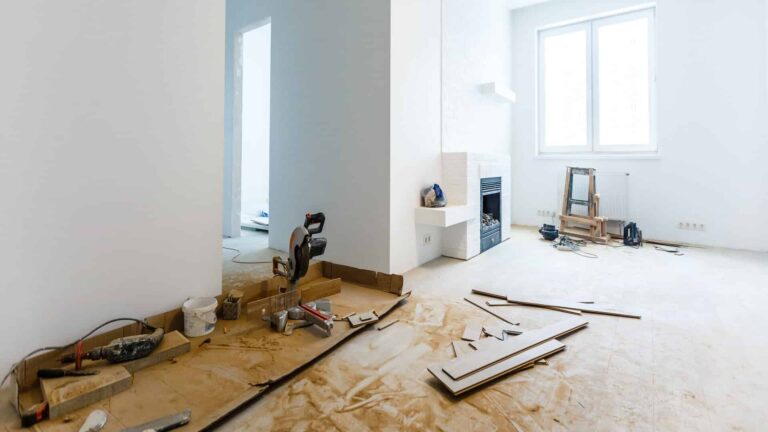So we all know buying real estate is awesome. You get cash flow, mortgage pay down from your tenants, and hopefully some sweet appreciation over time. But what about that fourth way to make money? That’s what I wanna talk about today.
Let me tell you something as I’ve been in this game for years now and I’ve learned which renovations actually put money back in your pocket and which ones just drain your bank account. Sure, you could go wild with custom mahogany built-ins or a fancy wine cellar, but are you gonna get that money back when you sell? Probably not.
I’m gonna walk you through the renovations that actually give you the best return on investment. These are the ones where you put in a dollar and get more than a dollar back when you sell or refinance. And I’ve seen this firsthand across dozens of properties in my portfolio.
Look, I know renovations can be scary. You’re worried about going over budget, hiring the wrong contractor, or picking finishes that go out of style faster than those fidget spinners everyone was obsessed with a few years back. But I’m gonna show you what actually works based on real projects I’ve done.
10 Renovations That Give You the Best ROI
Let’s talk about the renovations that are actually worth your time and money. These are the things that buyers and renters notice right away and are willing to pay more for. I’ve ranked these based on what’s given me the best results, but your market might be different.
1. Minor Kitchen Remodel
Number one is no surprise. The kitchen is the heart of the home, and that’s where you want to focus a good chunk of your renovation budget.
But here’s the thing. You don’t need to go nuts and spend 50 grand on a complete gut job. A minor kitchen remodel can get you way better ROI than a fancy high-end renovation. We’re talking about 70-80% return on your investment versus maybe 50-60% for those crazy expensive kitchens.
What do I mean by minor? New cabinet fronts instead of completely new cabinets. New hardware. Maybe a new sink and countertop. A fresh backsplash that pops.
In my properties, I stick with white cabinets and light countertops. Super neutral, super clean looking. It never goes out of style, and it appeals to almost everyone. Our average kitchen renovation costs about $8,000 to $10,000 for a rental, and it adds like $20,000 to the value of the property. That’s a no-brainer!
One property I did last year had this nasty 1980s oak kitchen with these weird country-style handles. We painted the cabinets white, added new modern hardware, put in a quartz countertop, and boom – the property appraised for $25,000 more than before. All for about $8,500 in renovation costs.
2. Energy-Efficient Upgrades
This one surprises a lot of people, but energy-efficient upgrades are killing it right now for ROI. Why? Because utility bills are through the roof, and people are willing to pay more for a place that’ll save them money every month.
I’m talking about adding insulation, upgrading to a smart thermostat, putting in LED lighting throughout, or installing a new energy-efficient water heater. These aren’t sexy renovations that people ooh and ahh over during showings, but they matter when it comes time to sell.
A study from vaious companies found that energy efficiency upgrades return about 68% of their cost immediately, but the real value is in the ongoing savings and the marketing advantage when you sell.
One of my properties had ancient heating systems that were costing my tenants a fortune. We spent about $4,200 upgrading to a high-efficiency system, and I was able to raise the rent by $75 a month because the tenants would be saving way more than that on utilities.
That’s an extra $900 a year in my pocket, which means the upgrade pays for itself in less than 5 years. Plus, the property value went up by about $6,000.
3. Replace Garage Door
This one blows my mind because it’s so simple. Replacing an old, beat-up garage door gives you one of the highest ROIs of any renovation – we’re talking 90-95% return on your money.
A new garage door costs around $3,500 to $4,000 installed, and it can add almost that much to your property value. Plus, it massively improves curb appeal, which gets more potential buyers or renters through the door.
I did this on a flip last summer. The house had this dented, faded garage door that looked terrible. We put in a new one with windows across the top for about $3,800, and it completely transformed how the house looked from the street.
The real estate agent told me it was one of the features that buyers mentioned most during showings.
4. Install New Windows and Doors
New windows and doors are another solid investment. They’re a bit pricier upfront – probably $10,000 to $15,000 for an average-sized house – but they typically return about 70% of that cost in added value.
The real win is when you’re marketing the property. You can talk about improved security, better energy efficiency, and reduced outside noise. Plus, they just look so much better.
I had this one property where the windows were so old you could feel a draft even when they were closed. We spent about $12,000 replacing all the windows and the front door.
Not only did the place immediately look way more updated, but the tenants were psyched about their lower heating bills.
I was able to bump the rent by $100 a month, which is an extra $1,200 a year – the windows will pay for themselves in 10 years just from that rent increase.
5. Bathroom Remodel
Bathrooms are the second most important room after kitchens. A clean, modern bathroom can make or break a deal when someone’s looking at your property.
Like kitchens, you don’t have to go crazy here. A mid-range bathroom remodel gives you way better ROI than a luxury one. We’re talking new vanity, new toilet, new flooring, fresh paint, and maybe updating the tub/shower.
In my properties, I always install double sinks if there’s space for it. People love that feature. And I keep everything light and bright – white subway tile, floating vanities, clean lines.
Our average bathroom renovation costs about $6,000 to $7,500, and it adds around $10,000 to $12,000 in value. That’s a 60-65% return, which is solid.
One of my favorite bathroom transformations was this gross 1970s bathroom with pink tile and a weird carpeted toilet lid cover thing. We gutted it, put in white tile, a modern gray vanity with double sinks, and one of those rainfall showerheads everyone loves.
Cost was about $7,200, and the property value jumped by $11,500. Plus, it rented for $125 more per month than similar units in the area.
In case, if you’re not sure what to do, opting for a shower replacement in Pittsburgh, PA can change the entire look and feel. Professional remodelers offer modern, low-maintenance options with a clean finish.
6. Upgrade the Flooring
Flooring is huge because it’s literally everywhere in your house. Bad flooring can kill a deal faster than almost anything else.
I’m a big fan of one consistent flooring throughout the main living areas. It makes the space feel bigger and more cohesive. None of this “different flooring in every room” nonsense that was popular in the 90s.
Luxury vinyl plank (LVP) is my go-to for rental properties. It looks like real wood, it’s basically indestructible, and it’s waterproof. We use a nice modern gray tone that goes with everything.
For a flip, I might use engineered hardwood in the main areas and LVP in wet areas like bathrooms and the laundry room.
New flooring runs about $4-6 per square foot installed, so maybe $8,000 to $12,000 for an average house. But it can increase your property value by $15,000 or more, especially if you’re replacing old carpet or dated vinyl.
I had this one property with five different types of flooring – carpet in some rooms, laminate in others, vinyl in the kitchen, tile in the bathrooms. It was a mess. We ripped it all out and put the same LVP throughout. Cost was about $11,000, but the appraised value jumped by $18,000, and it rented within two days of listing.
7. Attic Insulation
This is probably the least sexy renovation on this list, but man, the numbers don’t lie. Adding attic insulation has one of the highest ROIs of any home improvement – sometimes over 100%.
It costs about $1,500 to $2,000 to properly insulate an attic, and it can add $2,000 to $2,500 to your home’s value right away. Plus, it cuts down on energy bills, which is another selling point.
Most of my properties are older homes, and a lot of them had practically no insulation in the attic. We’d go up there and it was just sad – maybe 3 inches of old fiberglass that had been compressed over time. We’d blow in new insulation to bring it up to R-49 (that’s the recommended level in most northern states), and tenants would immediately notice the difference in comfort and energy bills.
One duplex I bought had $400+ heating bills in the winter. After adding proper attic insulation for about $1,800, the bills dropped to around $250. That’s a massive difference that makes the property much more attractive to tenants.
8. Basement Finishing
If you’ve got an unfinished basement, finishing it can add serious value and square footage to your property. This is a bigger project – probably $15,000 to $30,000 depending on size and features – but it can add 70-75% of that cost to your home’s value.
The key is to keep it functional. Add a bedroom if possible (make sure it has proper egress), a bathroom if plumbing allows, and an open rec area. Don’t go crazy with built-ins or custom features that not everyone will want.
I finished the basement in one of my single-family rentals last year. It was completely unfinished – concrete floors, exposed joists, the whole deal. We spent about $22,000 adding a bedroom, a three-quarter bathroom, and a nice open family room area.
The house appraised for $38,000 more afterward, and I was able to increase the rent by $250 per month.
That’s an extra $3,000 a year, so the renovation pays for itself in less than 8 years, not counting the added equity.
9. Outdoor Appeal Enhancements
This is all about first impressions. When someone pulls up to your property, what do they see? Is it inviting or does it look run down?
Simple landscaping, fresh mulch, a nice front door, updated house numbers and mailbox – these things might seem minor, but they set the tone for everything else.
For rental properties, I focus on low-maintenance landscaping that still looks good. No one wants to deal with a bunch of delicate plants that need constant care.
For a flip, I might go a bit further – maybe a new front walkway, landscape lighting, or a small deck or patio in the backyard.
You can make a huge difference in curb appeal for $2,000 to $5,000, and it can add $5,000 to $10,000 in perceived value. That’s a solid 100%+ return.
One of my properties had this overgrown mess of a front yard with a cracked concrete path. We spent about $3,800 clearing it out, putting in some simple landscaping with native plants, adding landscape fabric and fresh mulch, and installing a new stone walkway.
The transformation was incredible. The property looked like it was worth $20,000 more just from that first impression.
10. Interior Painting
Fresh paint is probably the cheapest way to transform a space. It’s amazing what a difference it makes.
For most of my properties, I stick with light gray walls throughout – maybe an accent wall in a nice blue or green in the living room. It’s neutral but not boring, and it goes with everything.
Painting an average house costs about $3,000 to $5,000 if you hire it out, and it can add $5,000 to $8,000 in value. That’s a 60-100% return, which is fantastic.
The best part is that paint is so affordable compared to most renovations. If you’re on a super tight budget, this is where you should start.
I bought this one property that had dark brown walls in the living room, bright yellow in the kitchen, and this weird sponge-painted texture in the bedrooms. It was awful.
We painted everything a light gray with white trim, and it was like a completely different house. Cost was about $4,200, and it easily added $7,000 to the value.
Factors that Influence ROI
Now, before you go running off to start these renovations, there are some things you need to consider. Not every renovation makes sense for every property in every market.
Target Audience
You need to think about who’s going to be buying or renting your property. Are they young professionals? Families with kids? Retirees? Students?
Different groups want different things. Young professionals might care a lot about a stylish kitchen and smart home features. Families care about bedroom count and school districts. Retirees might want single-level living and low-maintenance yards.
I’ve got some properties near a university, and for those, I focus on durable finishes, good internet connectivity, and maximizing bedroom count.
For my properties in family neighborhoods, I make sure the backyard is usable and there’s plenty of storage space.
Market Expectations in Your Area
What’s standard in your market? In some areas, granite countertops are expected. In others, laminate is totally fine. In some neighborhoods, central air is a must-have. In others, window units are the norm.
You don’t want to be the nicest house in a neighborhood full of fixer-uppers, and you don’t want to be the only property without features that buyers in your area expect.
I’ve got properties across several different cities, and what works in one doesn’t always work in another. In my higher-end areas, I install quartz countertops and stainless appliances because that’s what people expect.
In my starter home neighborhoods, I might use a nice laminate countertop and black appliances to keep costs down while still looking good.
Cost vs. Recoup
Always do the math before starting a renovation. What will it cost? What value will it add? How long will it take to recoup your investment through increased rent or sale price?
I track all my renovation costs and the resulting increase in property value or rent. Over time, I’ve learned exactly what gives me the best bang for my buck in different types of properties.
For rentals, I look at the monthly rent increase I can get from a renovation. If a $10,000 kitchen remodel lets me charge $100 more in rent each month, that’s $1,200 a year, so the renovation pays for itself in about 8.3 years. Plus, I’ve added to the property value.
Functional Upgrades
Sometimes the highest ROI comes from fixing functional issues rather than cosmetic ones. A new roof or updated electrical system might not be sexy, but they can be deal-breakers for buyers and lenders.
If your property has knob-and-tube wiring, a failing roof, or foundation issues, fix those before you worry about pretty backsplashes or fancy light fixtures.
I bought this one property that had beautiful updates throughout – new kitchen, new bathrooms, the works. But the inspection revealed the electrical panel was outdated and potentially dangerous. The sellers had to drop their price by $5,000 to account for that. If they had spent $2,500 updating the panel before listing, they would have come out $2,500 ahead.
Consult with Local Home Remodelling Professional
Every market is different, and trends change over time. A local real estate agent or appraiser can tell you which renovations are giving the best returns in your specific area right now.
I touch base with my real estate agent contacts at least twice a year to see what buyers are looking for and what’s giving the best ROI in my markets.
Conclusion
At the end of the day, the best renovations are the ones that solve problems. They take a space that doesn’t work well and make it functional, attractive, and efficient.
Focus your budget on the areas that matter most – kitchens, bathrooms, flooring, and energy efficiency. Keep finishes neutral but not boring. And always, always do the math before you start swinging hammers.
I’ve seen so many investors get caught up in making places look like something out of a magazine, but then they can’t recoup those costs when they sell or rent. Be smart about where you spend your money.
If you’re on a tight budget, start with paint and curb appeal. Those give you the biggest bang for your buck. As you build more capital, you can tackle the bigger projects like kitchens and bathrooms.
Remember, real estate investing is a numbers game. Every dollar you spend should have a purpose and a return. If you stick to these high-ROI renovations, you’ll maximize your profits and build wealth faster.



